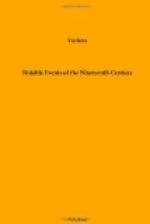The Prussians being armed with needle-guns, were enabled to get the double advantage of rapid firing by loading in a chamber at the breech of the piece, and the equally great advantage of a long range and most deadly missile; for in the cartridge of this gun the needle runs through the charge, firing it first at the front of the chamber, thus securing the whole force of the explosive, which burns backward in the enclosed space and expends itself entirely on the projectile. Those breech-loading pieces which fire the cartridge by percussion against its back end have the disadvantage of the charge burning forward, and thus wasting itself partly in the air after the bullet has left the muzzle. This difficulty, however, has been overcome in recent gunnery, and the needle-gun such as it was in the hands of King William’s soldiers at Sadowa, must now be regarded as a clumsy and obsolete weapon.
The battle of Sadowa was to Francis Joseph the handwriting on the wall; but he made vain exertions to save his tottering fabric. Now it was that the shadow of a great hand was seen behind the conflict. It was the hand of Bismarck. His scheme was the unification of Germany. The NORTH GERMAN UNION was formed on the basis of Protestantism and the unity of the German race. Already the Empire might be seen in the distance.
CAPTURE OF MEXICO.
Whatever may be said of the justice of our war with Mexico, no criticism can be offered as to the brilliancy of the result. The campaign of General Scott against the ancient capital of the Aztecs, was almost spectacular; certainly it was heroic.
On the ninth of March, 1847, the General, then nearly sixty-one years of age, arrived at Vera Cruz, with an army of 12,000 men. That city was taken in about a week, and the way was opened from the coast to the capital. The advance began on the eighth of April, and ten days afterward the rocky pass of Cerro Gordo was carried by assault. Santa Anna barely escaped with his life, leaving behind 3000 prisoners, his chest of private papers, and his wooden leg!
On the twenty-second of the same month, the strong castle of Perote, crowning a peak of the Cordilleras, was taken without resistance. Then the sacred city of Puebla was captured. On the seventh of August, Scott, with his reduced forces, began his march over the crest of the mountains against the city of Mexico. The American army, sweeping over the heights, looked down on the valley. Never before had a soldiery in a foreign land beheld a grander scene Clear to the horizon stretched a living landscape of green fields, villages, and lakes—a picture too beautiful to be marred with the dreadful enginery of war.




